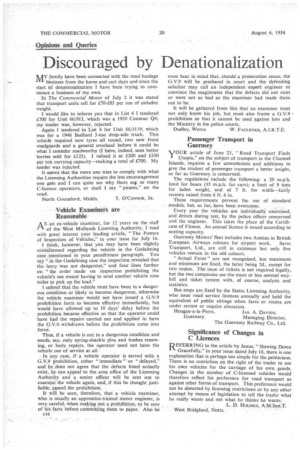Discouraged by Denationalization
Page 54

If you've noticed an error in this article please click here to report it so we can fix it.
j4Y family have been connected with the road haulage 1. business from the horse and cart days and since the start of denationalization I have been trying to commence a business of my own.
. In The Commercial Motor of July 2 it was stated that transport units sell for £70-£85 per ton of unladen weight.
would like to inform you that in List 4 I tendered £700 for Unit 66/913, which was a 1950 Comrner Q4; my tender was, however, rejected.
Again I tendered in List 6 for Unit 66/3119, which was for a 1946 Bedford 5-ton drop-side truck. This vehicle required new tyres all round, two new front mudguards and a general overhaul before it could be what I consider roadworthy (I have, indeed, seen better lorries sold for £125). I valued it at £200 and £100 per ton carrying capacity—making a total of £700. My tender was rejected.
It seems that the more one tries to comply with what the Licensing Authorities require the less encouragement one gets and I can quite see why there arg so many C-licence operators, or shall I say "pirates," on the road.
North Greenford, Middx. T. O'CONNOR, JR.
Vehicle Examiners are Reasonable
AS an ex-vehicle examiner, for 12 years on the staff of the West Midlands Licensing Authority, I read with great interest your leading article, "The Powers of Inspection of Vehicles," in your issue for July 16. I think, however, that you may have been slightly misinformed regarding the vehicle in the Godalming case mentioned in your penultimate paragraph. You say "'in the Godalrning case the inspection revealed that the lorry was not dangerous," and four lines further on "the order made on inspection prohibiting the vehicles use meant having to send another vehicle nine miles to pick up the load."
I submit that the vehicle must have been in a dangerous condition or likely to become dangerous, otherwise the vehicle examiner would not have issued a G.V.9 prohibition form to become effective immediately, but would have allowed up to 10 days' delay before the prohibition became effective so that the operator could have, had the repairs carried out and applied to have the 0.V.9/ withdrawn before the prohibition came into force.
Thus, if a vehicle is not in a dangerous condition and needs, say, only spring-shackle Pins and bushes renewing, or body repairs, the operator need not have the vehicle out of service at all.
. In any case, if a vehicle operator is served with a G.V.9 Prohibition, either " immediate " or " delayed," and be does not agree that the defects listed actually exist, he can appeal to the area office of the Licensing Authority and a senior officer will be sent out to examine the vehicle again, and, if this be thought justifiable, cancel the prohibition.
It will be seen, therefore, that a vehicle examiner, who is usually an apprentice-trained motor engineer, is very careful,-.when making out a prohibition, to be sure of his facts before conarnit,ting them to paper.' Also he c16 must bear in mind that, should a prosecution ensue, the G.V.9 will be produced in court and the defending solicitor may call an independent expert engineer to convince the magistrates that the defects did not exist or were not as bad as the examiner had made them out to be.
It will be gathered from this that an examiner must not only know his job, but .must also frame a G.V.9 • prohibition so that it cannot be used against him and the Ministry in the police courts. .
Dudley, Worcs. W. FAULKNER, A.I.R.T.E.
Passenger Transport in Guernsey
VOUR article of June 25, "Road Transport Finds Utopia," on the subject of transport in the Channel Islands, requires a few amendments and additions to give the student of passenger transport a better insight, so far as Guernsey is concerned.
The regulations include the following: a 20 m.p.h. limit for buses (35 rn.p.h. for cars); a limit of 9 tons for laden weight, and of 7 ft. for width—fairly recenty raised from 6 ft. 6 in.
These requirements prevent. the use of standard models, but, so far, have been overcome.
Every year thern vehicles are individually examined, and driven during test, by the police officer concerned and the engineer. This takes the place of the Certificate of Fitness. An annual licence is issued according to seating capacity.
Guernsey Motors' fleet includes two Austins in British European Airways colours for airport work. Sarre Transport, Ltd., are still in existence but only five vehicles remain in the old colours.
"Actual Fares" are not recognized, but maximum and minimum are fixed, the latter being 2d., exeept for two routes. The issue of tickets is not required legally, but the two companies use the more or less normal waybill and ticket system with, of course, analysis and statistics.
Bus stops are fixed by the States Licensing Authority, who issue road service licences annually and hold the equivalent of public sittings when fares or routes are under review or require alteration.
Hougue-a-la-Perre, JAS. A. DAVIES, Guernsey. Managing Director, The Guernsey Railway-Co., Ltd.
Significance of Changes in C Licences
REFERRING to the article by Janus, "Slowing Down Gracefully," in your issue dated July 16, there is one explanation that is perhaps too simple for the politicians. There is no restriction on the right of the trader to use his own vehicles for the carriage of his own goods. Changes in the number of C-licensed vehicles would therefore reflect his preference for road transport as against other forms of transport. This preference would not be distorted by licensing restrictions or by any other attempt by means of legislation to tell the trader what he really wants and not what he thinks he wants: L D. HOLMES, A.M.Inst.T. 'West Bridgford, Notts.




























































































